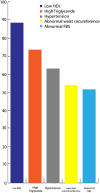Prevalence and associated factors of metabolic syndrome among patients with severe mental illness attending Amanuel Mental Specialized Hospital in Addis Ababa, Ethiopia: hospital-based cross-sectional study
- PMID: 40229724
- PMCID: PMC11995647
- DOI: 10.1186/s12888-025-06845-w
Prevalence and associated factors of metabolic syndrome among patients with severe mental illness attending Amanuel Mental Specialized Hospital in Addis Ababa, Ethiopia: hospital-based cross-sectional study
Abstract
Background: Metabolic syndrome (MetS) is the leading cause of mortality and morbidity in patients with severe mental illness (SMI). The present study was designed to determine the prevalence and associated factors of MetS among people with SMI attending the Amanuel Mental Specialized Hospital in Addis Ababa, Ethiopia.
Methods: A hospital-based cross-sectional study was conducted among people with SMI attending the outpatient psychiatric department. Socio-demographic and other clinical data were collected using a structured questionnaire. A standardized chemistry analyzer measured lipid profiles and blood glucose levels at the Ethiopian Public Health Institute. Univariable and multivariable logistic regression analysis was conducted to examine the association of the outcome with clinical and socio-demographic variables.
Results: A total of 305 participants with SMI were recruited, 79% (n = 241) were male. The overall prevalence of MetS was 28.5% (n = 87), 31.5% (n = 63) among all the participants diagnosed with schizophrenia, and 25% (n = 13) among participants diagnosed with bipolar disorders. The most frequent metabolic abnormality was low high-density lipoprotein (HDL) 88.5% (n = 77). About 54% (n = 47) had abnormal waist circumference; 27.5% (n = 84) of the participants had a blood pressure of ≥ 130/85 mmHg; 4.6% (n = 14) had fasting blood glucose above 100 mg/dl; and 36.4% (n = 111) had triglyceride levels above 150 mg/dl. On multivariable analysis, increasing age (Adjusted odds ratio (aOR) = 1.12, 95% CI 1.08, 1.16) and having secondary education and above (aOR = 2.64, 95% CI 1.24, 5.50) compared to primary education, increasing duration of treatment (aOR = 1.11, 95% CI 1.03, 1.18) and alcohol use (aOR = 1.89, 95% CI 1.03, 3.47) were associated with MetS. 27.2% (n = 83) of the participants with SMI were overweight, and 4.6% (n = 14) had obesity. Increasing age (aOR = 1.11, 95% CI 1.05, 1.14), being female (aOR = 2.42, 95% CI 1.17, 5.01), smoking (aOR = 2.83, 95% CI 1.30, 6.15) and use of second-generation antipsychotics (aOR = 2.64, 95% CI 1.41, 4.94) were significantly associated with being overweight/obesity.
Conclusions: Individuals with SMI receiving care at a tertiary healthcare facility in Ethiopia exhibited a high prevalence of overweight/obesity and MetS. Therefore, health education and early screening for the components of MetS in this vulnerable population are recommended.
Keywords: Bipolar disorder; Major depressive disorder; Metabolic syndrome; Schizophrenia; Severe mental illness.
© 2025. The Author(s).
Conflict of interest statement
Declarations. Ethics approval and consent to participate: Ethical clearance was obtained from the Institutional Review Board of Addis Ababa University College of Medicine and health sciences (Ref Number AAUMF 03–008) as well as Amanuel mental specialized Hospital Clinical Director office ((Ref Number Am/146/4/3). The study was conducted in line with the codes of the declaration of Helsinki for Ethical Principles for Medical Research Involving Human Subjects particularly vulnerable groups (World Medical Association Declaration of Helsinki: Nov 27, 2013). Participants were excluded if they did not have the capacity to give informed consent. Written informed consent was obtained from every study participant before data collection. Individuals were informed about the full right to refuse participation or withdrawal at any point in the study. The study involved drawing blood samples in line with the standard recommendations which only cause mild discomfort over the skin injection area only which is the same as the routine blood sample collection for any other patients. Otherwise the study subjects were not subjected to any other form of intervention which affects their health or treatment. The laboratory investigations were done at the Ethiopian Public Health Institute. Consent for publication: Not applicable. Competing interests: The authors declare no competing interests.
Figures
References
-
- Detection NCEPEPo, Adults ToHBCi. Third report of the National Cholesterol Education Program (NCEP) Expert Panel on detection, evaluation, and treatment of high blood cholesterol in adults (Adult Treatment Panel III): The Program; 2002. - PubMed
-
- Lindsay RS, Howard BV. Cardiovascular risk associated with the metabolic syndrome. Curr DiabRep. 2004;4(1):63–8. - PubMed
-
- Noubiap JJ, Nansseu JR, Lontchi-Yimagou E, Nkeck JR, Nyaga UF, Ngouo AT, et al. Geographic distribution of metabolic syndrome and its components in the general adult population: A meta-analysis of global data from 28 million individuals. Diabetes Res Clin Pract. 2022;188: 109924. - PubMed
MeSH terms
LinkOut - more resources
Full Text Sources
Medical



